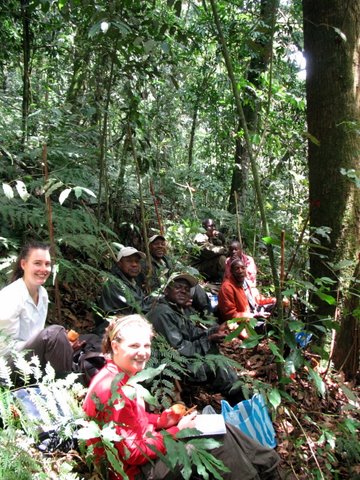|

In Bwindi
Impenetrable National Park (BINP) local community members are allowed to
extract certain forest products in a controlled way, within so called
‘multiple use zones’ (MUZs). Since 2004, ITFC monitors the impact of
harvesting on three selected species, by comparing their populations
inside and outside MUZs. Ocotea usambarensis Engl. (Lauraceae), a
tree from which bark is harvested to treat stomach aches and used for
deworming, is one of them. It has remained unclear, however, whether
current harvest levels for this species are sustainable.
In this
study the impact of Ocotea bark harvesting was addressed with so called
‘matrix model analysis’, used for modelling population dynamics. For the
construction of these models, annual growth of the trees’ diameter,
survival probabilities and reproduction rates need to be assessed.
ITFC’s monitoring data for 5 MUZs and 1 non-MUZ, collected over 5 years,
were kindly availed for this analysis and monitoring data for 2010 and
additional data to run the model were collected by me.
The goal
of the study was to analyse the impacts of bark harvest on population
structures and dynamics of Ocotea and to model the availability of the
resource in the future. This will give an indication whether current
harvest levels are sustainable.
A general
description of the current harvest levels and impacts showed that almost
all harvest took place on trees with a diameter thicker than 110 mm,
which contain more bark than smaller trees. In most cases, only a small
portion of the bark had been removed. Also, only a small percentage of
the trees (3.4% of the total population) was harvested over the last
years. There were no evidences that bark harvest had led to mortality of
a single individual in our study and most wounds were healing. Harvest
had taken place in MUZs as well as outside, and in fact was highest in
non-MUZ areas. Probably the distance from the road and the occurrence of
alternative species determine more where people harvest than
regulations.
The population structure of Ocotea within each MUZ showed that
the size class distribution was generally stable over the years. Most
populations showed a distribution with more juveniles than adults,
indicating natural, density-stable and self-replacing populations.
Population structures differed between the MUZs, but this is probably
due to differences in environment rather than in harvest levels.
For the construction of matrix population models ‘vital rates’ (diameter
growth rates, survival probabilities and reproduction rates) were
calculated.
Unharvested and harvested individuals were separated in each area to
assess and compare their growth rates. Currently, only a few individual
stems have been tagged. To improve the estimations of the vital rates in
these models, it is recommended to tag all stems for monitoring.
A matrix model was constructed for the harvested and unharvested
population. Diameter growth rates of the harvested population were
significantly higher than those of the unharvested population, which may
be due to a non-random selection of harvestable trees. The survival
probability was assumed to be equal in both populations. Reproduction
rates were calculated in an alternative way, which resulted in higher
reproduction rates of the harvested population. Both populations showed
a positive population growth rate, but the population
growth rate
of the harvested population was higher, contradictory to findings in the
literature. Simulation of stem
availability in harvested and unharvested population showed an increase
in total number of stems in the next twenty years for both. However,
assumptions had to be made which may be questionable (e.g. constant
environmental factors). We recognise that ecological differences across
sites may have influenced the population growth rates as well.
The conclusion is that current levels of bark harvest from O.
usambarensis in BINP are low and seem sustainable. Monitoring the
impact of harvest on its populations remains important in the
future. Population dynamics as well as harvest intensity may change and
this might has consequences for the sustainability. Data in this study
did not fully fit the requirements for the construction of matrix
population models. If the park management wants to monitor the impacts
of harvest levels on plant populations with matrix model
analysis, the monitored stems should be individually and permanently
tagged.
|


